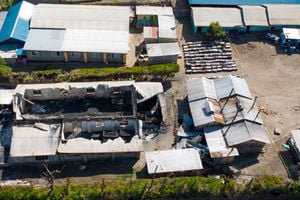KDHS 2022: Women headed households have increased over the last eight years

Attendees at the launch of the 2022 Kenya Demographic and Health Survey main report at KICC, Nairobi on July 3 ,2023.
More women in urban areas have taken over the decision-making role in the household.
This is according to the Kenya Demographic Health Survey (KDHS) 2022, which shows that the number of female-headed households in urban areas has increased from 27 to 31 per cent in the last eight years.
At the national level, a third of households in Kenya are still headed by women, as was the case in 2014.
Similar to the 2014 report, female-headed households are more common in rural areas at 36 per cent. Factors contributing to female-headed households include separation, divorce or widowhood.
The report shows that overall, the percentage of women who are separated or divorced is nearly double that of men at 11 per cent compared to five per cent for men.
Women aged 45 to 49 were more likely than any other age group to have lost a spouse, been separated or divorced.
A high number of divorced, separated or widowed women were also active in the labour market.
Also read: Intense awareness campaign key to ending FGM
Of 3,897 such women, 76 per cent were employed, compared with seven per cent who were reported as unemployed.
Elementary occupations were found to be the most common among divorced, separated or widowed women.
Apart from these occupations, the most common occupations among this category of women were service workers, shop and market sales workers (23 per cent) or skilled agricultural, fishery, hunting and related workers (17 per cent).
The head of a household plays a role in determining other characteristics of the household, such as the number of children in school and the distribution of family income.
Between 2003 and 2022, the proportion of females and males aged six years and over with no education decreased from 23 to 13 per cent for women and from 16 to 10 per cent for men. Women and men in urban areas have the highest median number of years of education completed.
Nairobi City was found to have the highest median number of years of schooling at nine years for both women and men. In the arid and semi-arid counties of Tana River, Garissa, Mandera, Wajir, Turkana, Samburu and Marsabit, the median number of years of schooling for women is zero.
The proportion of the population with more than secondary school education was found to increase with wealth, with the highest proportion of women (33 per cent) and men (38 per cent) in the highest wealth bracket.
The survey also shows that children in urban areas have higher attendance rates at both primary and secondary schools than their counterparts in rural areas.
Conversely, the gross primary school attendance rate is higher in rural areas at 108 per cent compared to 104 per cent in urban areas.
According to the report, there is parity in primary school attendance, reflected in a Gender Parity Index (GPI) of 1.02. However, at the secondary level, the GPI rises to 1.16, indicating that girls outnumber boys.
According to the report, net enrolment in primary school is positively correlated with household wealth, rising from 75 per cent in the lowest wealth quintile to 92 per cent in the highest. In contrast.
"The net attendance rate (NAR) at primary school increases with increasing household wealth. The NAR for primary school increases from 75 per cent in the lowest wealth quintile to 92 per cent in the highest wealth quintile, while the NAR for secondary school is lower in rural areas than in urban areas, at 46 per cent and 58 per cent respectively," the report says.
The report also highlights both positive and worrying trends in school attendance and educational attainment across different demographic groups. The report shows that overall, 12 per cent of women and 13 per cent of men in the country have completed more than secondary education. Meanwhile, 13 per cent of women and 10 per cent of men have no education, and around 15 per cent of both sexes have only completed primary school.
One encouraging finding of the report is a declining trend in the proportion of people aged 6 and over with no education.
"Between 2003 and 2022, there is a declining trend in the proportion of women and men aged 6 and over with no education, from 23 per cent to 13 per cent for women and from 16 per cent to 10 per cent for men," the report says. This indicates progress in expanding educational opportunities for the population.
The report also highlights disparities in educational attainment based on geographic location and wealth. Women and men living in urban areas have a higher median number of years of education completed, at 7.7 years for women and 8.0 years for men, compared to those living in rural areas, where the median is 6.1 years for women and 6.3 years for men.
Turkana has the lowest NAR at 44 per cent and GAR at 57 per cent for primary school, while Nyandarua has the highest NAR at 95 per cent. For secondary school, Tana River County has the lowest GAR at 34 per cent, while Kirinyaga County has the highest at 113 per cent.
The report includes data on participation rates in organised learning activities before the official age of primary school enrolment. It shows that 88 per cent of children aged 5 participated in such activities, with 66 per cent attending early childhood development programmes and 22 per cent attending primary school.






